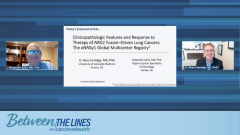
Key Takeaways From the eNRGy1 Global Multicenter Registry Study
Experts Alexander Spira, MD, PhD, FACP, and D. Ross Camidge, MD, PhD, share insight and key takeaways from the eNRGy1 global registry study.
Episodes in this series

Transcript:
Alexander Spira, MD, PhD, FACP: Hello, and welcome to the discussion portion of [CancerNetwork®] Between the Lines, a journal club experience. We just reviewed the article, “Clinicopathologic Features and Response to Therapy of NRG1 Fusion-Driven Lung Cancers: the eNRGy1 Global Multicenter Registry.” We’re now going to discuss this a little bit more and get some more thoughts. Here’s today’s featured article. Ross, what are some takeaways from this paper?
D. Ross Camidge, MD, PhD: Let’s just look at how amazing this is. We’re describing new diseases, here we are in the 21st century and we are describing new diseases. This is saying NRG1 fusion-positive non–small cell lung cancer, it’s out there, it’s real, it’s super rare, but it’s not Bigfoot. These are confirmed sightings, and what does it look like? It tends to occur in somewhat older patients, and you can have a smoking history unlike some driver oncogenes. It doesn’t seem super responsive to most standard therapies, there’s a little bit of a response to afatinib. Its pattern of metastatic spread just looks like lung cancer. Those were my takeaways.
Alexander Spira, MD, PhD, FACP: I would echo that exactly. I always love listening to you describe the mechanism of action. We’re talking about ligand and heterodimers, and the working of afatinib as well as some new drugs. Truly understanding the science here is amazing. I know it probably sounds simple right now, but think about how much work and how many years have gone into just understanding the biology of it. We talked a little bit about DNA and RNA fusions, we have the technology now to find these. If you take a step back, the last 5 years with some of these rare ones have been amazing.
D. Ross Camidge, MD, PhD: Let me jump in there just for a second. I think one of the things about these NRG1 fusions is there are slightly more assumptions that when we see this genetic change, that that’s going to turn into a driver oncogene state. If you have an EGFR mutation, you are pretty confident that that’s going to turn into an aberrant looking kinase, which is going to signal and it’s going to be responsive to targeted therapy. Here, you’ve got a fusion, which if you remember the analogy we used was like dinosaurs and the length of the neck, between the head and the body. That’s a variable, sometimes there’s no head on the dinosaur, which sounds like a really bad idea. Even then, if that’s sitting on the surface of the cell, we then have to make the assumption that’s going to interact with HER3. We then have to make the assumption that’s going to partner with some other thing within the HER family, and that’s going to cause signaling. We are building layers of assumptions here, and so it may not be a slam dunk every single time.
Alexander Spira, MD, PhD, FACP: Do we know how many different fusion partners there are right now?
D. Ross Camidge, MD, PhD: There are 10 or 20, there are a few common ones. In this series, I think CD74 was a common one; CD74, you may remember, is a common fusion partner for ROS1 as well. It’s a general scaffold protein. We are pulling some of it apart. Here it’s not actually the fusion partner that is the issue, it’s the length of the neck on the dinosaur that is the biggest variable.
Alexander Spira, MD, PhD, FACP: I’ll keep that in mind, maybe if you have young kids, they might appreciate that more.
Transcript edited for clarity.
Newsletter
Stay up to date on recent advances in the multidisciplinary approach to cancer.



















































































